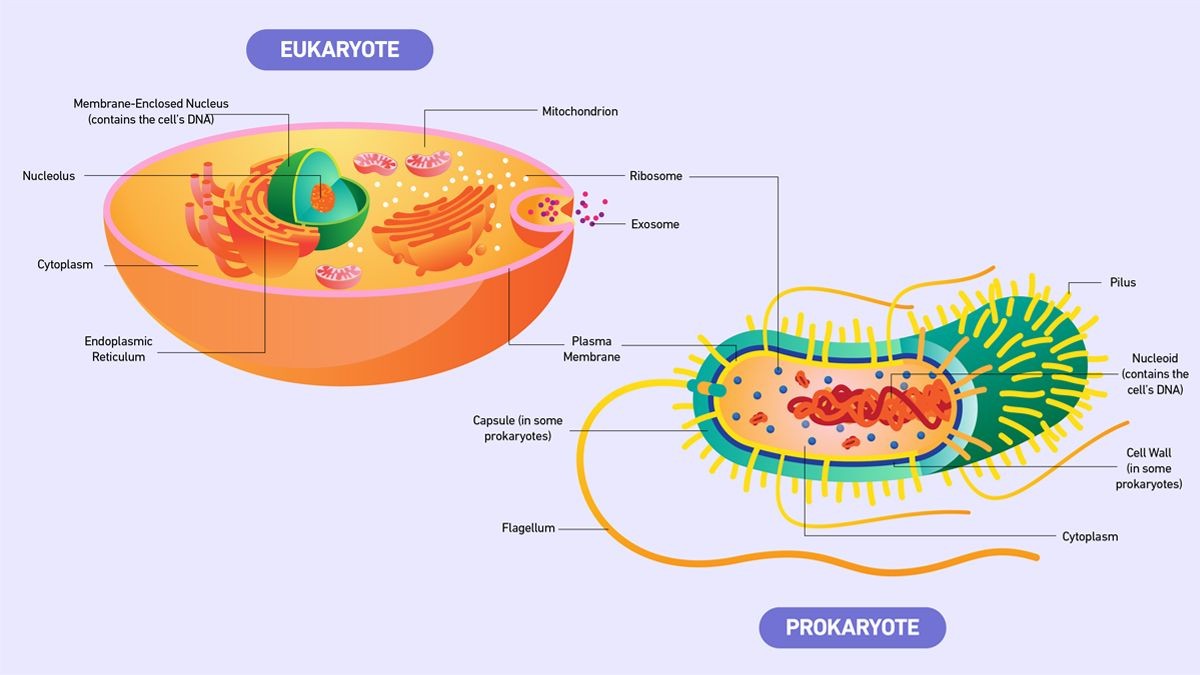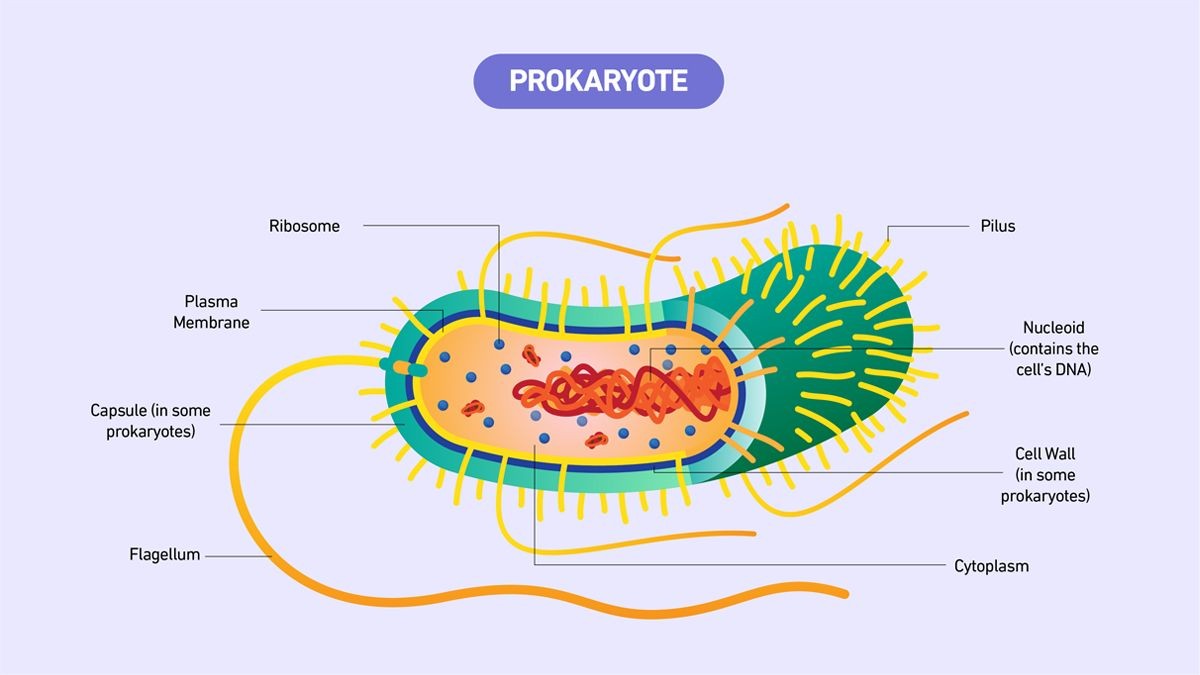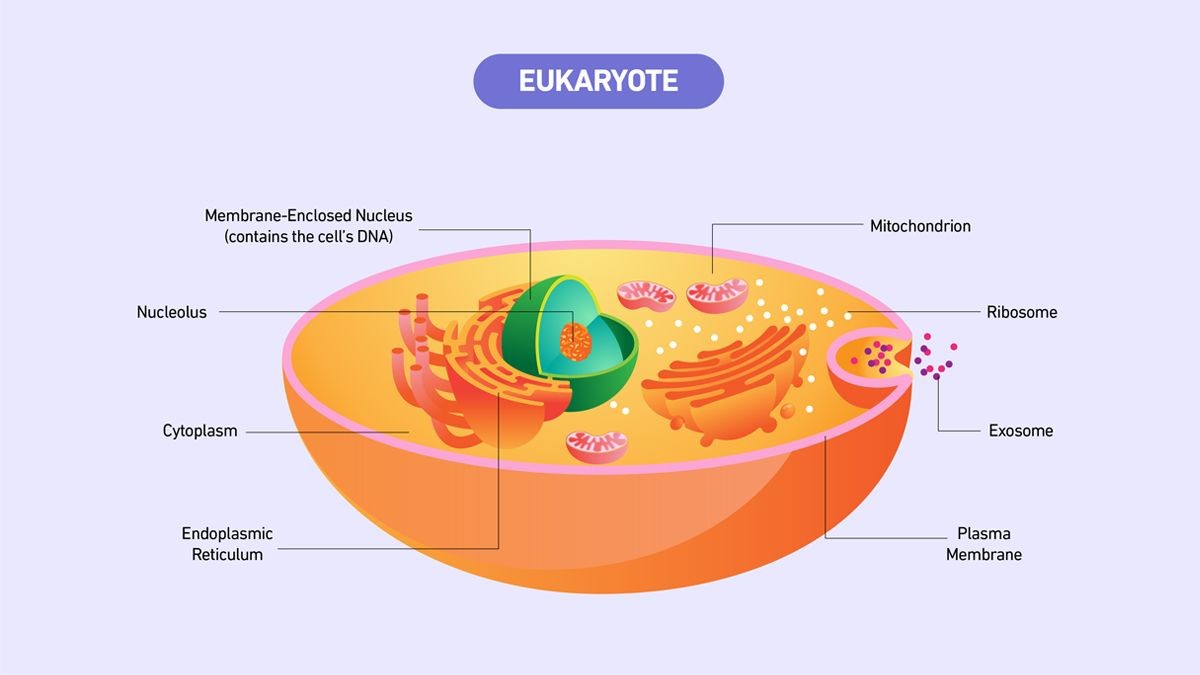The Compare And Contrast Of Eukaryotic And Prokaryotic Cells reveals fundamental differences in their structure, function, and evolutionary history, influencing the complexity and diversity of life on Earth. At COMPARE.EDU.VN, we aim to provide a comprehensive comparison, highlighting both the similarities and differences between these two cell types, offering clarity for students, researchers, and anyone curious about the building blocks of life. Explore the intricacies of cellular biology, uncovering the nuances between prokaryotic and eukaryotic organisms, and understand how their unique characteristics shape their roles in the biological world.
1. Introduction to Eukaryotic and Prokaryotic Cells
Prokaryotic and eukaryotic cells represent the two primary classifications of cells that constitute all living organisms. Prokaryotes, generally simpler and smaller, encompass bacteria and archaea, while eukaryotes, typically more complex and larger, include animals, plants, fungi, and protists. The key distinction lies in their cellular organization: eukaryotic cells possess a membrane-bound nucleus and other organelles, whereas prokaryotic cells lack these defined structures. Understanding these differences is essential for grasping the breadth of biological diversity.
2. The Evolutionary History of Cells
Scientists believe that prokaryotes emerged as the first form of life on Earth, approximately 3.5 billion years ago. Eukaryotes are thought to have evolved from prokaryotes around 2.7 billion years ago through a process called endosymbiosis.
Endosymbiosis proposes that two prokaryotic cells entered into a symbiotic relationship, eventually merging into a single, more complex cell. This process is believed to have led to the development of membrane-bound organelles such as mitochondria and chloroplasts. Mitochondria provided eukaryotic ancestors with the energy needed to evolve into the complex eukaryotic cells we see today.
However, recent research suggests that some prokaryotic bacteria can ingest other cells, challenging the traditional view that only eukaryotes can perform endocytosis. These findings prompt a reevaluation of the origins of eukaryotes.
3. Key Similarities Between Prokaryotes and Eukaryotes
Despite their differences, prokaryotic and eukaryotic cells share several fundamental characteristics essential for life:
- DNA: Both cell types use DNA as their genetic material, carrying the instructions for cell function and reproduction.
- Plasma Membrane: A plasma membrane encloses the cell, acting as a barrier that separates the internal environment from the external surroundings. This membrane regulates the transport of substances in and out of the cell.
- Cytoplasm: Both cell types contain cytoplasm, a gel-like substance composed of water, salts, and organic molecules. The cytoplasm houses the cell’s organelles and is the site of many metabolic reactions.
- Ribosomes: Ribosomes are responsible for protein synthesis in both prokaryotic and eukaryotic cells. These structures translate genetic code from messenger RNA into proteins.
4. Detailed Comparison: Prokaryotes vs. Eukaryotes
The primary distinction between prokaryotes and eukaryotes lies in their cellular structure and organization. Here’s a detailed comparison:
4.1. Presence of a Nucleus
- Prokaryotes: Lack a true nucleus. Their DNA is located in a nucleoid region, which is not enclosed by a membrane.
- Eukaryotes: Possess a nucleus, a membrane-bound organelle that houses the cell’s DNA.
4.2. Membrane-Bound Organelles
- Prokaryotes: Do not have membrane-bound organelles.
- Eukaryotes: Contain various membrane-bound organelles such as mitochondria, endoplasmic reticulum, Golgi apparatus, and lysosomes.
4.3. Cell Structure
- Prokaryotes: Predominantly unicellular, meaning they exist as single cells.
- Eukaryotes: Can be either unicellular or multicellular, forming complex organisms.
4.4. Cell Size
- Prokaryotes: Generally smaller, ranging from 0.1 to 5 μm in diameter. However, a much larger bacterium (centimeter-long) has recently been discovered in a mangrove swamp.
- Eukaryotes: Larger, typically ranging from 10 to 100 μm in diameter.
4.5. Complexity
- Prokaryotes: Simpler in structure and organization.
- Eukaryotes: More complex, with specialized organelles performing specific functions.
4.6. DNA Structure
- Prokaryotes: DNA is often circular, existing as a single chromosome. Linear plasmids and chromosomes have been found in certain prokaryotes.
- Eukaryotes: DNA is linear and organized into multiple chromosomes within the nucleus.
4.7. Examples
- Prokaryotes: Bacteria and archaea.
- Eukaryotes: Animals, plants, fungi, and protists.
Table 1: Comparing Prokaryotic and Eukaryotic Cells
| Feature | Prokaryote | Eukaryote |
|---|---|---|
| Nucleus | Absent | Present |
| Membrane-Bound Organelles | Absent | Present |
| Cell Structure | Unicellular | Mostly multicellular; some unicellular |
| Cell Size | Typically smaller (0.1–5 μm) | Larger (10–100 μm) |
| Complexity | Simpler | More complex |
| DNA Form | Often circular, sometimes linear | Linear |
| Examples | Bacteria, archaea | Animals, plants, fungi, protists |



5. Transcription and Translation: Prokaryotes vs. Eukaryotes
Transcription and translation are two fundamental processes in gene expression, but they differ significantly between prokaryotes and eukaryotes.
5.1. Transcription and Translation in Prokaryotes
In prokaryotic cells, transcription and translation are coupled. This means that translation begins while the mRNA is still being synthesized from the DNA template. Because there is no nucleus, both processes occur in the cytoplasm, allowing ribosomes to bind to the mRNA as it is being transcribed.
5.2. Transcription and Translation in Eukaryotes
In eukaryotic cells, transcription and translation are spatially separated. Transcription occurs in the nucleus, where DNA is transcribed into mRNA. The mRNA then exits the nucleus and enters the cytoplasm, where translation takes place. This separation allows for RNA processing steps, such as splicing, capping, and polyadenylation, which are essential for producing mature mRNA.
6. Prokaryotic Cells: A Closer Look
Prokaryotes, divided into bacteria and archaea, are unicellular organisms that lack membrane-bound structures. These cells are generally small, ranging from 0.1 to 5 μm in diameter, and play crucial roles in various ecosystems.
6.1. Features of Prokaryotic Cells
- Nucleoid: A central region containing the cell’s DNA, but not enclosed by a membrane.
- Ribosomes: Responsible for protein synthesis.
- Cell Wall: Provides structure and protection; typically made of peptidoglycans in bacteria.
- Cell Membrane: Separates the cell from its external environment.
- Capsule: A layer of carbohydrates surrounding the cell wall, aiding in attachment and protection.
- Pili: Rod-shaped structures involved in attachment and DNA transfer.
- Flagella: Thin, tail-like structures used for movement.
6.2. Examples of Prokaryotes
Bacteria and archaea are the two primary types of prokaryotes. Bacteria are incredibly diverse and can be found in various environments, from soil to the human gut. Archaea, often found in extreme environments, share characteristics with both bacteria and eukaryotes.
6.3. The Absence of a Nucleus
Prokaryotes lack a nucleus; their DNA is bundled together in a nucleoid region. This DNA typically consists of a single, circular chromosome.
6.4. The Absence of Mitochondria
Prokaryotes do not have mitochondria, the organelles responsible for energy production in eukaryotes. Prokaryotes generate energy through different metabolic pathways in the cytoplasm and cell membrane.
7. Eukaryotic Cells: An In-Depth Analysis
Eukaryotes are organisms with cells that contain a nucleus and other organelles enclosed by a plasma membrane. These cells are larger (10–100 μm) and more complex than prokaryotic cells.
7.1. Features of Eukaryotic Cells
- Nucleus: Stores the cell’s genetic information in the form of chromatin.
- Nucleolus: Located within the nucleus, responsible for producing ribosomal RNA.
- Plasma Membrane: A phospholipid bilayer surrounding the cell and its organelles.
- Cytoskeleton: A network of protein fibers that provides shape and support to the cell.
- Cell Wall: Found in plant cells and some fungi; provides structural support and protection.
- Ribosomes: Responsible for protein synthesis.
- Mitochondria: Powerhouses of the cell, responsible for energy production through cellular respiration.
- Cytoplasmic Space: The region between the nuclear envelope and plasma membrane.
- Cytoplasm: The total inner-cellular volume, excluding the nucleus, including the cytosol and all organelles.
- Cytosol: The gel-like substance within the cytoplasm, excluding the contents of membrane-bound organelles.
- Endoplasmic Reticulum: An organelle involved in protein maturation and transportation.
- Vesicles and Vacuoles: Membrane-bound sacs involved in transportation and storage.
7.2. Examples of Eukaryotes
Animals, plants, fungi, algae, and protozoans are all examples of eukaryotes. These organisms exhibit a wide range of complexity and play diverse roles in ecosystems.
8. Functional Differences and Adaptations
Eukaryotic and prokaryotic cells exhibit significant functional differences due to their structural variations. Eukaryotic cells, with their membrane-bound organelles, can perform more complex functions, such as endocytosis and exocytosis. This allows for specialized processes like hormone secretion and nutrient uptake. Prokaryotic cells, although simpler, are highly adaptable and can thrive in diverse environments. Their metabolic diversity allows them to perform unique functions such as nitrogen fixation and bioremediation.
9. Implications for Medicine and Biotechnology
Understanding the differences between eukaryotic and prokaryotic cells has significant implications for medicine and biotechnology. Many antibiotics target prokaryotic-specific structures, such as the cell wall or ribosomes, without harming eukaryotic cells. In biotechnology, prokaryotic cells are often used for producing recombinant proteins and synthesizing drugs. Eukaryotic cells are crucial for studying human diseases and developing therapies for complex conditions.
10. Recent Advances in Cell Biology
Recent advances in cell biology have further refined our understanding of both eukaryotic and prokaryotic cells. Advanced imaging techniques, such as super-resolution microscopy, have allowed scientists to visualize cellular structures in unprecedented detail. Genomic studies have revealed the diversity and evolutionary relationships among different cell types. These advances continue to shape our understanding of the fundamental building blocks of life.
11. Conclusion: Appreciating Cellular Diversity
In conclusion, the compare and contrast of eukaryotic and prokaryotic cells highlights the remarkable diversity and complexity of life at the cellular level. Eukaryotic cells, with their intricate organization and specialized organelles, support complex multicellular organisms. Prokaryotic cells, with their simplicity and adaptability, play vital roles in ecosystems and offer valuable tools for biotechnology. Understanding these differences is crucial for advancing our knowledge of biology, medicine, and biotechnology.
Are you struggling to compare and contrast complex biological concepts like eukaryotic and prokaryotic cells? Visit COMPARE.EDU.VN for detailed and objective comparisons that help you make informed decisions. Whether you’re a student, researcher, or simply curious, our platform provides the insights you need. Explore the world of cellular biology and beyond with COMPARE.EDU.VN. Contact us at 333 Comparison Plaza, Choice City, CA 90210, United States, or call us at +1 (626) 555-9090. Visit our website at compare.edu.vn today.
12. Frequently Asked Questions (FAQ)
- What is the main difference between prokaryotic and eukaryotic cells?
- The main difference is that eukaryotic cells have a nucleus and other membrane-bound organelles, while prokaryotic cells do not.
- Are bacteria prokaryotic or eukaryotic?
- Bacteria are prokaryotic cells.
- Do viruses fall under prokaryotic or eukaryotic cells?
- Viruses are not cells and therefore do not fall under either category. They are acellular entities.
- What is the size range of prokaryotic cells?
- Prokaryotic cells typically range from 0.1 to 5 μm in diameter.
- Can eukaryotic cells exist as single-celled organisms?
- Yes, some eukaryotic cells, such as protists, can exist as single-celled organisms.
- What role do ribosomes play in prokaryotic and eukaryotic cells?
- Ribosomes are responsible for protein synthesis in both prokaryotic and eukaryotic cells.
- Do prokaryotic cells have DNA?
- Yes, prokaryotic cells have DNA, but it is not enclosed within a nucleus.
- What is the function of mitochondria in eukaryotic cells?
- Mitochondria are responsible for energy production in eukaryotic cells through cellular respiration.
- Where does transcription occur in prokaryotic cells?
- Transcription occurs in the cytoplasm of prokaryotic cells.
- What are some examples of eukaryotic organisms?
- Examples of eukaryotic organisms include animals, plants, fungi, algae, and protozoans.